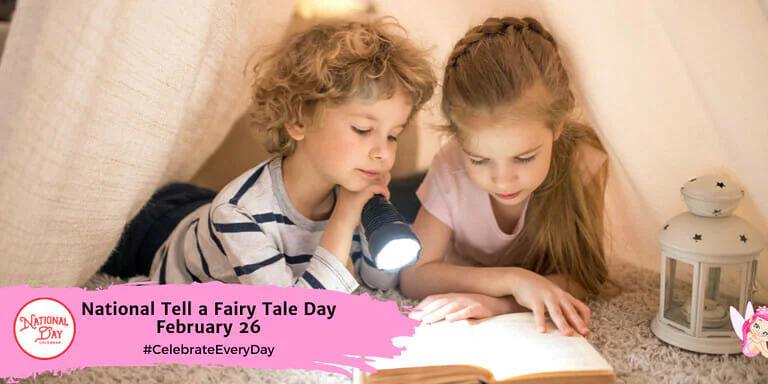Tell a Fairy Tale Day
February 26, 2024
“Once upon a time…”
Celebrated on February 26, nationwide Tell a Fairy Tale Day is the perfect day for us to sit down and remember all the fairy tales we were told as children. Many of us grow up with the adventures of Cinderella, Rapunzel or Sleeping Beauty being told before our bedtime. We couldn’t wait to explore the myths and stories of our favorite characters, mostly with the perfect happy ending. But these fairy tales weren’t always what they seem…
Most of the traveling storytellers told stories which would nowadays be rated as inappropriate for children, featuring painful punishments and sadistic parents. They often had a moral twist and a feared lesson for its child listeners. Each oral retelling changed the stories, making them more and more dramatic and less and less realistic.
The fact that oral storytelling has been preserved in time immemorial is truly fascinating. The first fairy tales were told in the Bronze Age before the advent of our literary record began.
Some of them are still known today, like “Beauty and the Beast” or “Rumpelstiltskin,” both of which are over 4000 years old. And “Jack and the Beanstalk” could be traced back to when Eastern and Western Indo-European languages split more than 5,000 years ago! Those stories have been told before the languages English, French and Italian existed.
A lot of people know the German Grimm Brothers, who are considered to be the first ones who collected, wrote down and then published fairy tales, but around 200 years before them Charles Perrault collected and published the very first fairy tales. He spent most of his life at the court of Versailles, serving King Louis XIV.
Jacob and Wilhelm Grimm published their first collection in 1812, and it is now one of the most popular collections including Cinderella, the Beauty and the Beast, Snow White, and many more. In total, the Grimm Brothers collected 200 fairy tales throughout their lifetimes. To collect all the different fairy tales, they traveled for six years through a lot of German villages, listening to the stories the people handed down to each other from generation to generation.
While the Grimms may not have been the first, they certainly weren’t the last, and they inspired other people to collect fairy tales in their footsteps. One of such collectors is Hans Christian Anderson from Denmark. He wrote down 156 fairy tales in his lifetime.
The Grimm Brothers thought they were going to write down the morals emanated naturally from the German people from oral tradition, morals which they wanted to preserve before the tales were lost forever, but they never intended the stories to be read to children. Now the fairy tales are translated into 160 languages. Every time a story was translated into another language, certain aspects were changed. Translators changed the urban setting, so it is more realistic for the people from other cultures.
One of the most interesting facts of fairy tales is that they change over time. Nowadays, we all associate fairy tales as kids’ stories and forget about their dark origins. The people collecting them started to “tone it down” in the 18th century.
In the 20th century most people are familiar with classic fairy tales through Disney’s adaptations.But in the last couple of years, Disney received a lot of criticism for their adaptations. The company was accused of stereotypical portrayal of non-white characters and sexism. In the article “The Trouble With Disney’s Teeny, Tiny Princesses,” Time Magazine criticizes the fact that men in Disney films are often portrayed as bigger and stronger with women who are dependent on them and often need to be protected or rescued. “The exaggerations in these children’s movies are extreme, they almost always promote the same image of big men and tiny women, and they are especially dramatic in romantic situations.”
In more recent years, Disney appears to recognize that women can also be strong, independent heroes, some examples being seen in “Mulan,” “Frozen,” and “Moana.” In these movies, the protagonist women played a strong female role as opposed to a damsel in distress.
Fairy tales tell us stories about who we are, can become, and where we came from. They play a big part in many people’s lives, and “Tell a fairy tale day” encourages people to keep the beautiful tradition of storytelling alive.
Citations:
Roller, S. (Ed.). (2021, October 22). The disturbing origins of fairy tales.
HistoryHit. Retrieved March 2, 2023, from https://www.historyhit.com/culture/the-disturbing-origins-of-fairy-tales/
National tell a fairy tale day. (2023, February). Daysoftheyear. Retrieved March
2, 2023, from
https://www.historyhit.com/culture/the-disturbing-origins-of-fairy-tales/
Zipes, J. (Ed.). (2015, April). How the Grimm Brothers Saved the Fairy Tale.
Humanities. Retrieved March 2, 2023, from
https://www.neh.gov/humanities/2015/marchapril/feature/how-the-grimm-brothers-saved-the-fairy-tale
NATIONAL TELL A FAIRY TALE DAY – February 26. (2023, February 22). Retrieved
March 2, 2023, from
https://nationaldaycalendar.com/national-tell-a-fairy-tale-day-february-26/

